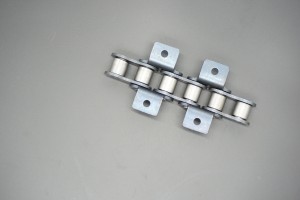Advantages and Disadvantages of Roller Chain Heat Treatment
Heat treatment is a crucial step in the roller chain manufacturing process. While this process can significantly improve roller chain  performance, it also has some significant disadvantages.
performance, it also has some significant disadvantages.
1. Principles of Roller Chain Heat Treatment
Heat treatment of a roller chain involves heating and cooling the entire chain to improve its internal structure and thus enhance its mechanical properties. Common heat treatment processes include quenching, tempering, carburizing, and nitriding. For example, quenching rapidly cools the chain to create a hardened structure on the surface and inside, thereby increasing hardness and strength. Tempering, on the other hand, reduces the internal stresses generated during quenching and increases the chain’s toughness.
2. Advantages of Roller Chain Heat Treatment
(1) Significantly Improves Strength and Hardness
Heat treatment can significantly improve the strength and hardness of roller chains. Through processes such as quenching and tempering, the chain’s internal structure is optimized, resulting in a finer grain structure, significantly increasing its tensile strength and surface hardness. This is particularly important for roller chains that must withstand heavy loads and frequent impacts, effectively extending their service life.
(2) Enhanced Wear Resistance
The wear resistance of roller chains after heat treatment is significantly enhanced. For example, the carbonitriding process forms a wear-resistant carbonitriding layer on the chain surface, effectively reducing wear during operation. This not only extends the chain’s service life but also reduces maintenance costs caused by wear.
(3) Improved Fatigue Life
Overall heat treatment effectively reduces residual stress within the chain, thereby increasing its fatigue life. In practical applications, heat-treated roller chains can maintain stable performance under high loads and frequent starts and stops, reducing the risk of fatigue fracture.
(4) Improved Overall Performance
Overall heat treatment not only enhances the strength and wear resistance of the roller chain but also significantly improves its overall performance. For example, heat-treated chains can maintain excellent performance even in harsh environments such as high temperature and high humidity. This has important practical significance for roller chains used in complex operating conditions.
3. Disadvantages of Roller Chain Heat Treatment
(I) Risk of Deformation During Heat Treatment
During the heat treatment process, the chain may deform due to uneven heating and cooling. This deformation can affect the chain’s dimensional accuracy and assembly precision, leading to problems such as the chain sticking or tooth skipping during operation. Therefore, the heating and cooling rates must be strictly controlled during the heat treatment process to minimize the possibility of deformation.
(II) Complex Process and High Cost
The heat treatment process for roller chains is complex, requiring precise control of parameters such as heating temperature, holding time, and cooling medium. This not only places high demands on equipment and processes but also increases production costs. Furthermore, strict quality inspections are required during the heat treatment process to ensure the stability and reliability of the heat treatment results.
(III) Potential Impact on Surface Quality
During the heat treatment process, oxidation and decarburization may occur on the chain surface, affecting its surface quality. These surface defects not only affect the chain’s appearance but also reduce its wear and corrosion resistance. Therefore, appropriate surface treatments, such as sandblasting and painting, are required after heat treatment to improve the surface quality.
4. Conclusion
Full-body heat treatment of roller chains offers significant advantages, such as increased strength, hardness, wear resistance, and fatigue life, effectively enhancing the performance and service life of roller chains. However, this process also has drawbacks, including the risk of heat treatment deformation, a complex and costly process, and potential degradation of surface quality.
Post time: Aug-29-2025

